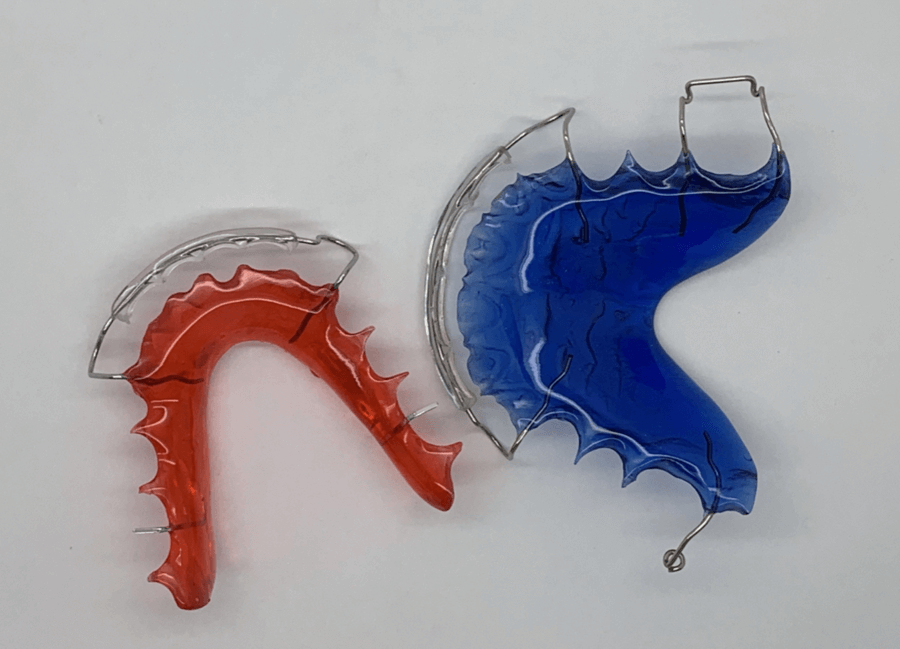What is the Hawley plate and what is it used for?
Hawley plate is a type of removable retainer used in orthodontics to hold teeth in position after treatment with brackets or aligners. It is composed of:
- Acrylic base, which adapts to the palate or the lingual part of the jaw.
- Labial wire, which crosses the front of the anterior teeth to keep them aligned.
- Attachment clasps, which are anchored to the molars to provide stability.
It is a durable, adjustable and easy-to-clean option, although less esthetic than clear retainers.
Differences between Hawley Plate and plastic retainers
The main differences between Hawley plate and clear retainers (such as Essix or Vivera) are:
|
Hawley Plate |
Essix or Vivera |
|
|
Material and structure |
Acrylic and metal wires |
Thermoformed plastic without wires |
|
Aesthetics |
Less aesthetic, the wires are visible. |
More discreet, hardly noticeable. |
|
Durability |
More resistant and can be adjusted if there are small recurrences. |
It wears faster and cannot be adjusted. |
|
Comfort and adaptability |
It may feel bulkier on the palate, but allows better contact between the teeth. |
It is more comfortable, but covers the entire tooth surface and may affect occlusion in the long term. |
|
Hygiene |
Easier to clean, less plaque retention. |
It can accumulate more tartar and stain over time. |
Both work well if the patient is consistent with their use.
Hawley plate operation
- Passive retention: Maintains the final position of the teeth after orthodontic treatment.
- Minor adjustments: The wire can be modified for limited movement of the anterior teeth.
- Occlusal expansion or modification: In some cases, an expander screw is incorporated for transverse adjustments.
Indications and contraindications
Indications:
- Post-orthodontic retention: This is the most common use to avoid relapses after treatment with brackets or aligners.
- Correction of minor tooth movement: Can be used to make minor adjustments in alignment.
- Slight transverse expansion: When an expander screw is incorporated, it allows limited arch expansion.
- Correction of mild deep bite: May include bite planes for deprogramming or intrusion of incisors.
- Mild bruxism cases: In certain cases, it may protect teeth from nighttime wear.
- Growing patients: Can be combined with other orthopedic elements to guide maxillary development.
Contraindications:
- Non-collaborative patients: As it is removable, its effectiveness depends on the patient’s discipline.
- High esthetic cases: Not ideal for patients who prefer discreet options, such as clear retainers.
- Need for rigid retention: In cases where there is a lot of post-treatment instability, a fixed retainer may be better.
- Severe speech problems: May temporarily affect phonation, which could be a problem in people with specific speech needs.
- Allergic to acrylic or metals: Patients with sensitivity to these materials may require alternatives.
How to care for Hawley plate
In order for the retainer to last longer and maintain its function correctly, it is important to follow this care:
Daily cleaning:
- Wash after each use: Rinse with cold or warm water (never hot).
- Gentle brushing: Use a soft-bristled toothbrush with mild soap or non-abrasive toothpaste.
- Immerse in cleaning solution (optional): Effervescent tablets for prosthesis can be used 1-2 times per week, but do not overdo it so as not to damage the metal.
Use and storage:
- Always store in its case when not in use to avoid loss or breakage.
- Do not wrap in napkins: It can be accidentally thrown away.
- Avoid extreme heat: Do not leave it in the car, near radiators or in the sun, as the acrylic may deform.
- Keep away from pets: Dogs love to chew them.
Check with the orthodontist regularly to make sure it continues to fit properly; do not try to adjust it at home if it becomes loose or uncomfortable; always go to the clinic.
By following these recommendations, the retainer will last longer and keep the teeth in the correct position.
Why are retainers important after orthodontics?
Retainers are essential after orthodontic treatment because they prevent teeth from returning to their original position, a phenomenon known as relapse.
- Prevent relapse: After brackets or aligners are removed, teeth tend to move due to the elastic memory of the periodontal ligament.
- Enable bone and gingival stability: Bone and soft tissues need time to reorganize around the new tooth position.
- Maintain the achieved occlusion: They ensure that the bite is correctly stabilized, avoiding occlusal interferences.
- Compensate for natural growth and changes: Tooth position can change with age, and retainers help minimize these effects.
- Avoid additional treatment: Without retention, relapses may occur requiring orthodontic retreatment.


